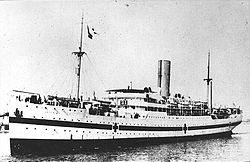Letitia (ship, 1912)
|
The Letitia during the First World War
|
||||||||||||||||||||||
|
||||||||||||||||||||||
|
||||||||||||||||||||||
|
||||||||||||||||||||||
|
||||||||||||||||||||||
|
||||||||||||||||||||||
The Letitia (I) was a 1912 passenger ship of the British shipping company Donaldson Line , which was used in passenger and mail traffic between Great Britain and Canada . During the First World War she served as a hospital ship until she ran aground on August 1, 1917 near Halifax and sank.
The ship
The 8,991 GRT steamship Letitia was built at Scotts Shipbuilding and Engineering Company in Greenock, Scotland . The steel- built combined passenger and cargo steamer was 143.3 meters long and 17.3 meters wide. The Letitia had a chimney , two masts and two propellers and was powered by two triple expansion steam engines that together developed 962 nominal horsepower and allowed a speed of 14 knots. The ship was built to carry 300 passengers in second class and 950 in third class.
The Letitia was the somewhat larger sister ship of the Saturnia (8,611 GRT), which was commissioned in 1910, was in service until 1925 and was scrapped in 1928. The Saturnia, in turn, was a further development of the Cassandra (7,396 GRT) built in 1906 , the first ship of the Donaldson Line designed for passenger service.
The Letitia was launched on February 21, 1912 and left Glasgow on May 4, 1912 on her maiden voyage to Quebec and Montreal . The service time as a passenger ship was short. After the outbreak of the First World War, the Letitia was drafted into service as a hospital ship by the British Admiralty and converted accordingly. She served in the Mediterranean and came under fire once while evacuating wounded troops near the Dardanelles .
On November 27, 1916, the Letitia rescued the survivors of the passenger ship City of Birmingham of the British Ellerman Lines and the Karnak of the French Messageries Maritimes , both of which had been sunk south of Malta by the German submarine U 32 without warning. In the same year, the Letitia and the other ships of the Donaldson Line became the property of the newly formed corporation Anchor-Donaldson Line.
Downfall
On August 1, 1917, the Letitia approached the port of Halifax with 137 crew members, 546 wounded Canadian soldiers and an 84-person medical staff on board . A pilot came on board at the port entrance, but he calculated the ship's position incorrectly due to the thick fog . Within ten minutes, the steamer ran aground 600 meters south of Portuguese Cove. Due to the proximity to the port, other ships were quickly on site to help. All soldiers were rescued, but one of the coal trimmers was accidentally left behind and drowned while attempting to swim ashore.
In the months following the accident, the wreck began to break in two and sink into deeper waters. It is a popular diving destination today.
Web links
- Data overview in the wreck database
- Short description of the ship in The Ships List (below)
- The Letitia in the Clydebuilt Ships Database (with picture)
- The Letitia on a Canadian website about shipwrecks ( Memento from July 26, 2013 in the Internet Archive )
- The Letitia in Shipwrecks of Nova Scotia ( April 9, 2013 memento in the Internet Archive )
Individual evidence
Coordinates: 44 ° 31 '4.8 " N , 63 ° 31" 44.4 " W.

